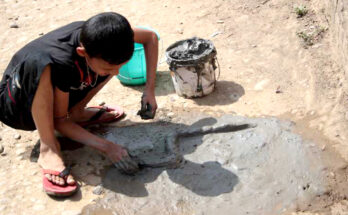
Celebrating Tradition and Unity: The Significance of April Sajibu Cheiraoba Festival in Manipur
Imphal April 13 , 2024 Imphal By Banti Phurailatpam
The Significance of April Sajibu Cheiraoba Festival in Manipur
Introduction:
In the picturesque state of Manipur, nestled in the northeastern corner of India, the arrival of spring heralds the celebration of April Sajibu Cheiraoba, a vibrant festival that holds deep cultural, religious, and social significance for the people of Manipur. As communities come together to mark the beginning of the Manipuri lunar calendar year, April Sajibu Cheiraoba serves as a time for reflection, renewal, and rejoicing, honoring age-old traditions, enhancing ties within the family and encouraging a feeling of cohesion and acceptance. In this comprehensive news article, we delve into the rich tapestry of April Sajibu Cheiraoba, exploring its rituals, customs, and enduring legacy in the heart of Manipur.
1: Unveiling the Essence of April Sajibu Cheiraoba
1.1 Historical Roots:
- April Sajibu Cheiraoba, also known as Meetei Cheiraoba, is celebrated on the first day of the Manipuri lunar month of Sajibu, which falls in April according to the Gregorian calendar.
- The festival traces its origins to ancient Meitei traditions and indigenous rituals, symbolizing the transition from darkness to light, winter to spring, and old to new.
1.2 Spiritual Significance:
- April Sajibu Cheiraoba holds profound religious significance for the Meitei community, who offer prayers and seek blessings from deities such as Umang Lai, the household deity, and Pakhangba, the serpent king.
- Rituals include cleaning and purifying homes, lighting lamps and torches, offering prayers at temples and sacred sites, and seeking blessings from elders and ancestors.
2: Customs and Traditions
2.1 Feast of Abundance:
- Central to the celebration of April Sajibu Cheiraoba is the preparation and sharing of sumptuous feasts, featuring traditional Manipuri dishes such as eromba (fermented fish curry), nga-thongba (fish stew), and chamthong (mixed vegetable stew).
- Families come together to prepare elaborate meals, exchange culinary delights with neighbors and relatives, and partake in communal feasting as a symbol of abundance and hospitality.
2.2 Rituals of Renewal:
- April Sajibu Cheiraoba is a time for introspection and renewal, with individuals reflecting on past achievements, seeking forgiveness for past wrongs, and setting intentions for the year ahead.
- Rituals may include taking ceremonial baths in natural water bodies, planting saplings and flowers, and performing acts of charity and kindness to cleanse the mind, body, and spirit.
3: Cultural Expressions and Performances
3.1 Traditional Attire and Ornaments:
- During April Sajibu Cheiraoba, Manipuri men and women don traditional attire such as phanek (wrap-around skirt), innaphi (shawl), and potloi (kurta) adorned with intricate embroidery and motifs.
- Jewelry such as kongphel (necklace), thabak (bracelet), and khongmang (earrings) add a touch of elegance and cultural pride to the festive attire.
3.2 Folk Music and Dance:
- Festivities are enlivened by traditional Manipuri music and dance performances, including the graceful movements of the Lai Haraoba dance, the rhythmic beats of the Pung cholom drum dance, and the melodious tunes of the Nata Sankirtan devotional music.
- Community gatherings, cultural events, and street processions showcase the vibrancy and diversity of Manipuri performing arts, fostering a sense of cultural identity and pride among participants.
4: Contemporary Relevance and Community Engagement
4.1 Preserving Heritage and Identity:
- Despite the passage of time and changes in societal dynamics, April Sajibu Cheiraoba continues to serve as a beacon of cultural resilience and identity for the people of Manipur.
- Efforts to preserve and promote traditional customs, rituals, and artistic expressions are undertaken by cultural institutions, community organizations, and grassroots initiatives to ensure the continuity of Manipuri heritage for future generations.
4.2 Promoting Unity and Harmony:
- April Sajibu Cheiraoba transcends religious and ethnic boundaries, bringing together people of diverse backgrounds, beliefs, and communities in a spirit of unity, harmony, and mutual respect.
- Through shared rituals, cultural exchanges, and collaborative endeavors, April Sajibu Cheiraoba reinforces the bonds of kinship and solidarity among Manipuri communities, fostering a sense of belonging and collective pride in their cultural heritage.
Conclusion:
As Manipuris across the globe come together to celebrate April Sajibu Cheiraoba, they not only honor their rich cultural heritage and traditions but also reaffirm their commitment to unity, harmony, and collective well-being. In the midst of modernity and rapid change, April Sajibu Cheiraoba serves as a timeless reminder of the enduring values of resilience, gratitude, and community that continue to define the spirit of Manipur. As the festival unfolds, let us join hands in celebrating the beauty and diversity of Manipuri culture, while cherishing the bonds of kinship and solidarity that unite us all. Cheiraoba Nongma Panba Amasung Amaiba Mangal Oiriba!
Celebrating Tradition and Unity: The Significance of April Sajibu Cheiraoba Festival in Manipur Read More